DSC-L1: Sony's Latest Ultra-Compact Digicam
by Stephen Caston on January 27, 2005 12:05 AM EST- Posted in
- Digital Camera
The Design: Sony DSC-L1
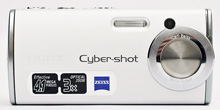 |
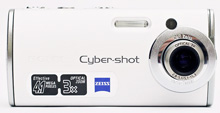 |
| Click images to enlarge. | |
The front of the DSC-L1 features its 3x Carl Zeiss Vario-Tessar optical zoom lens. The lens is protected by a sliding metal door that moves out of the way to allow the lens to extend when the camera is powered on. Just above the lens is the Self-timer/AF-assist lamp. To the left of this is the thin built-in flash. When the camera is set to Auto ISO, the flash has a working range of 0.7' - 6.6' at wide angle and 1.6' - 4.9' at telephoto. Although this flash range is rather short, it is not unusual for cameras of this size. The left side of the camera is left open to leave room for your grip.
On the back of the camera is a 1.5" LCD monitor with ~78K pixels. Just below the LCD are three buttons: Image size/Delete, Display, and Menu. To the right of these buttons is a multi-controller for navigating the menu. In addition, each direction corresponds to a recording function. Press the controller up to toggle between multi-pattern and spot metering, down to enter review mode, up to toggle the various flash modes, and down to enable a self-timer. The controller can also be pushed in to select items in the menus. Above the multi-controller is the speaker as well as small bumps to increase traction on your thumb while holding the camera. At the upper-right corner is the flash/charge light. This light will blink while the flash is charging. It will also light up during a self-timer shot or while the battery is being charged.
On the top of the camera are the microphone and main power button. To the right of this is the Mode switch with options to enter playback, still image, and movie modes. To the right of the Mode switch is the shutter button. Finally, at the far right is the zoom controller, which serves to operate the optical/digital zoom in record mode as well as to magnify images in playback.
 |
 |
| Click images to enlarge. | |
On the bottom of the camera is a tiny screw mount on the right side. However, there is nothing to fear; the supplied tripod adapter attaches to the camera via a thumbscrew. Although we didn't find it necessary, the screw also has a slit for a flathead screwdriver. After attaching the tripod adapter to the camera, it is ready to be fitted to a standard tripod screw.
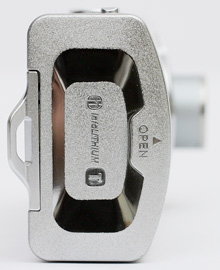 |
 |
| Click images to enlarge. | |
On the right side of the camera is a spring-action sliding door that conceals the battery compartment and Memory Stick Duo slot. The camera comes with a NP-FT1 rechargeable battery, which takes about 2.5 hours to recharge from a completely depleted state. Sony bundles a 16MB Memory Stick Duo with the camera. However, we highly recommend starting out with something more like 128MB. The Memory Stick Duo is approximately a third of the physical size of the regular Memory Stick. Luckily, Sony has included a Memory Stick Duo adapter that allows you to use the Duo in regular Memory Stick devices (card readers and other Memory Stick electronics). Just to the lower right of the flash card slot is a disk activity light. Also on this side is a post for the included wrist strap.
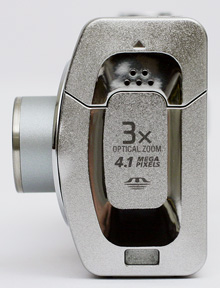 |
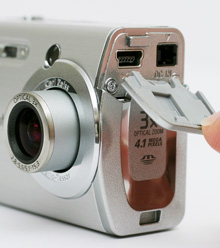 |
| Click images to enlarge. | |
On the left side of the camera is a plastic sliding tab that covers the USB and DC-in ports. On the bottom of this side is a notch where the tripod adapter snaps in to add further security.
The Sony DSC-L1 feels very solid in our hands. The body is constructed almost entirely of metal and is shaped in a brick-like design. The only possible design-wise drawbacks that we notice are a relatively small LCD monitor and the absence of a viewfinder. On the other hand, we are happy to see the inclusion of an AF-assist lamp on such a small camera. Now, let's move on to the recording capabilities of this little digicam.



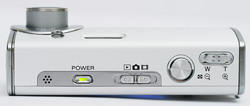








7 Comments
View All Comments
ksherman - Sunday, January 30, 2005 - link
BTW #6-- to get to contact information, click on 'about' on the left hadn menu (second down) and then click on 'contactAnandtech'Xmate - Saturday, January 29, 2005 - link
Good review, camera seems weak to me (being a photographer) but for a digicam its good, and a good review of it.I notice that Anandtech has taken a liking to digital photography, having several reviews and essays on how to take better photographs and what to take them with. This is all very good. I am really happy that more people are getting involved into the world of photography.
What I ask of Anandtech now, is to continue on their photography reviews, but to add some computer software preformance reviews. I am in the market for a new computer, and i am completely torn as to what CPU, motherboard, ram, graphics card HD to get. I will be using almost exclusively Adobe products on the computer (photoshop, illustrator, Golive Indesign, The whole Creative suite). I'd GREATLY aoreicate if Anandtech could have some benchmarkings of how different Hardware preforms in photoshop and more importantly their ram converter.
Also, I ask that you could perhaps have some reviews of colour calibration devices, such as the Gretagmacbeth ones (www.gretagmacbeth.com) and also if you could tell us what monitors are the best to use for the most acurate colour rendition.
It's great that you have more photographers articles, but people like me (you'd be surprised how many of us visit this site) really need advice on what PC hardware to get for the best and faster results, from cpu to graphics card to monitor to printer. I hope you take this into consideration.
Stefan
PS: I was looking for the 'Contact Us' for Anandtech, but I was unable to find it. If someone could tell me how to contact them directly then I'd greatly apreciate it. Thank you once again.
melgross - Friday, January 28, 2005 - link
As far as I am concerned, all of the test pictures are unacceptable. The outdoor pics aren't bad, though there are better images from others cameras in this price range.The indoor pics are all underexposed badly, and the flash calibration esp. at close distances is very poor.
segagenesis - Thursday, January 27, 2005 - link
Better and less than half the price of my old (4 years old?) DSC-P1. Guess it shows how quickly cameras are evolving.There will always be some edge distortion in smaller cameras, so when buying one this is a given. The lens is just too damn small!
stephencaston - Thursday, January 27, 2005 - link
#1 thanks, its corrected nowarfan - Thursday, January 27, 2005 - link
Maybe it will be better if there is review for all digital camera from entry level until high-end. What about Canon A75 compare with this Sony ?cosmotic - Thursday, January 27, 2005 - link
Are you sure you meant that the release date was Feb 2004?